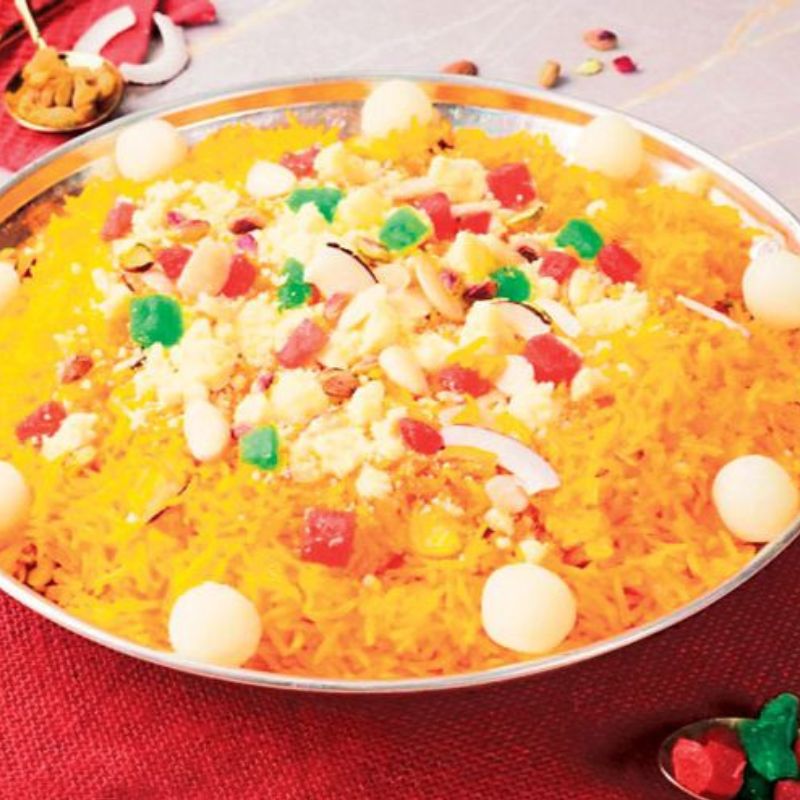Zarda, a traditional South Asian sweet rice dish, is one of the most beloved desserts in Pakistan and India. Rich in color, flavor, and cultural significance, it’s commonly served at weddings, festive gatherings, and religious celebrations. Whether you’re a food lover looking to try something authentic or someone wanting to recreate a piece of childhood nostalgia, this guide to the zarda recipe will help you understand its origins, ingredients, and preparation methods, while debunking a few common myths.
What Is Zarda?
Zarda is a sweet rice dish made with basmati rice, sugar, ghee (clarified butter), and a mix of aromatic spices such as cardamom and cloves. Traditionally, it’s colored with yellow food coloring or saffron and garnished with nuts, raisins, and candied fruits (tutti frutti). The name “Zarda” comes from the Persian word zard, meaning yellow.
The zarda recipe varies slightly from region to region and household to household, but its essence remains the same—sweet, fragrant, and rich.
Ingredients in a Classic Zarda Recipe

Creating the perfect zarda requires a careful balance of ingredients to achieve the desired sweetness, texture, and aroma.
Basic Ingredients:
- 1 cup basmati rice
- 3/4 cup sugar (adjust to taste)
- 2-3 tablespoons ghee
- 3-4 green cardamom pods
- 2-3 cloves
- 1 small cinnamon stick
- A pinch of saffron or yellow food coloring
- 2 tablespoons chopped almonds
- 2 tablespoons raisins
- 2 tablespoons tutti frutti (optional)
- 2 cups water
These ingredients can be customized, especially the garnishing part. Some variations also include khoya (milk solids) or coconut flakes for added richness.
How to Make Zarda – Step-by-Step Method
Here’s a simple and authentic way to prepare zarda at home:
Step 1: Soak the Rice
Wash and soak the basmati rice for about 30 minutes. This helps the rice cook evenly and enhances its fluffy texture.
Step 2: Boil the Rice
Boil the rice in water until it’s 80% cooked. Drain the water and set the rice aside.
Step 3: Prepare the Sugar Syrup
In a separate pan, melt sugar in 1/2 cup of water along with saffron or food coloring, cardamom, cloves, and cinnamon. Let it simmer for 5 minutes.
Step 4: Add Ghee and Nuts
In a heavy-bottomed pot, heat ghee. Add the soaked rice and gently mix it with the sugar syrup. Layer the chopped nuts, raisins, and tutti frutti on top.
Step 5: Simmer
Cover the pot tightly and allow the rice to steam on very low heat for about 10–15 minutes. This process, known as dum, helps infuse flavors and allows the sugar syrup to be absorbed evenly.
Step 6: Serve Warm
Fluff the rice gently and serve warm. Zarda is best enjoyed fresh but can be refrigerated and reheated as well.
Cultural Significance of Zarda
Zarda holds a special place in South Asian cuisine, especially during Eid, weddings, and family feasts. In Mughal times, it was considered a royal dessert, and the elaborate use of nuts and saffron reflected luxury and abundance.
Even today, preparing a perfect zarda recipe is considered a mark of culinary skill in many households. It’s more than just food—it’s a memory, a tradition, and a celebration.
Myths and Misconceptions About Zarda
Despite its popularity, there are a few myths surrounding zarda:
Myth 1: Zarda is Just Colored Sweet Rice
While it may appear simple, a good zarda recipe involves precise cooking techniques and the right balance of flavoring. It’s more than just yellow rice with sugar—it’s about texture, aroma, and richness.
Myth 2: It’s Too Sweet to Be Healthy
Like all desserts, moderation is key. Using healthier alternatives like jaggery or reducing the sugar slightly can make it more balanced without losing flavor.
Myth 3: Zarda Is Difficult to Make
The process may seem complex, but once you try it a couple of times, it becomes a simple and enjoyable dish to prepare. The key is to follow the timing carefully and use good-quality ingredients.
Frequently Asked Questions (FAQs)
1. Can I make zarda with brown rice?
Yes, but it will change the flavor and texture. Brown rice is denser and nuttier, so the zarda may not turn out as light and aromatic.
2. What can I use instead of saffron?
Yellow food coloring is commonly used. For a natural substitute, turmeric in very small quantities can be used but be cautious as it alters the taste.
3. Can I use oil instead of ghee?
Yes, but ghee adds a unique richness and aroma. If you’re health-conscious, use a mix of oil and ghee.
4. How do I prevent the rice from getting mushy?
Don’t overcook the rice during boiling. It should be about 80% done before steaming.
5. Can I add khoya to zarda?
Absolutely! Khoya adds richness and creaminess. Just crumble and layer it over the rice before the final steam.
Conclusion
The zarda recipe is a celebration of culture, tradition, and flavor. It’s one of those timeless dishes that evoke memories of home, family, and festivities. Whether you’re preparing it for a special occasion or just to treat yourself, mastering zarda is well worth the effort.
From the aroma of cardamom to the vibrant colors of nuts and fruits, every bite of zarda tells a story. And now that you’ve explored the zarda recipe—from ingredients and steps to cultural background and common myths—you’re ready to bring this royal dish to life in your own kitchen.For more delicious traditional recipes, tips, and food stories, visit MindScribes. Discover the best of South Asian culinary heritage and start your flavor journey today!

